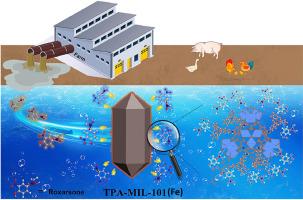Triphenylamine functionalized metal-organic framework NH2-MIL-101 (Fe) for efficient removal of roxarsone from wastewater
IF 4.7
3区 材料科学
Q1 CHEMISTRY, APPLIED
引用次数: 0
Abstract
Roxarsone (3-nitro-4-hydroxyphenylarsenic acid, ROX) is easily converted into highly toxic inorganic arsenic compounds, therefore, the development of highly efficient adsorbents for the removal of ROX from wastewater is necessary but remains challenging. In this study, NH2-MIL-101 (Fe) was synthesised and modified with TPA-CHO (4-(N, N-diphenylamine) benzaldehyde) to obtain TPA-MIL-101(Fe) with triphenylamine functionalised groups. The modified TPA-MIL-101(Fe) exhibits the very high adsorption capacity (728.2 mg g−1) and fast adsorption equilibrium (2 h). The TPA-MIL-101(Fe) showed excellent selectivity, and the adsorption efficiency hardly decreased in the presence of competing ions (Cl−, NO3−, SO42−). The TPA-MIL-101(Fe) showed good adsorption performance for ROX at pH 3–13, with the best performance at pH = 9. In addition, TPA-MIL-101(Fe) was able to remove trace amounts of ROX from actual water samples (<5 mg L−1) with an efficiency of 99.46 %, and the remaining ROX content meets the international drinking water standards of the World Health Organization (29 μg L−1). The mechanism studies have shown that the Fe-O-As coordination and the π-π stacking interaction between TPA-MIL-101(Fe) and ROX greatly enhance its adsorption performance. In conclusion, this work provides a promising material for effective removal of ROX from the environmental water.

三苯胺功能化金属-有机骨架NH2-MIL-101 (Fe)高效去除废水中的罗沙胂
Roxarsone(3-硝基-4-羟基苯基larsenic acid, ROX)很容易转化为剧毒的无机砷化合物,因此,开发高效吸附废水中ROX的吸附剂是必要的,但仍然具有挑战性。本研究合成了NH2-MIL-101 (Fe),并用TPA-CHO (4-(N, N-二苯胺)苯甲醛修饰得到了具有三苯胺官能团的TPA-MIL-101(Fe)。改性后的TPA-MIL-101(Fe)具有很高的吸附量(728.2 mg g−1)和快速的吸附平衡(2 h)。TPA-MIL-101(Fe)表现出优异的选择性,在Cl−、NO3−、SO42−竞争离子存在时,其吸附效率几乎没有下降。TPA-MIL-101(Fe)在pH为3 ~ 13时对ROX有良好的吸附性能,在pH = 9时吸附效果最好。此外,TPA-MIL-101(Fe)对实际水样中痕量ROX (5 mg L−1)的去除效率为99.46%,剩余ROX含量达到世界卫生组织国际饮用水标准(29 μ L−1)。机理研究表明,Fe- o - as配位和TPA-MIL-101(Fe)与ROX之间的π-π堆积相互作用大大提高了其吸附性能。总之,本研究为有效去除环境水中ROX提供了一种有前景的材料。
本文章由计算机程序翻译,如有差异,请以英文原文为准。
求助全文
约1分钟内获得全文
求助全文
来源期刊

Microporous and Mesoporous Materials
化学-材料科学:综合
CiteScore
10.70
自引率
5.80%
发文量
649
审稿时长
26 days
期刊介绍:
Microporous and Mesoporous Materials covers novel and significant aspects of porous solids classified as either microporous (pore size up to 2 nm) or mesoporous (pore size 2 to 50 nm). The porosity should have a specific impact on the material properties or application. Typical examples are zeolites and zeolite-like materials, pillared materials, clathrasils and clathrates, carbon molecular sieves, ordered mesoporous materials, organic/inorganic porous hybrid materials, or porous metal oxides. Both natural and synthetic porous materials are within the scope of the journal.
Topics which are particularly of interest include:
All aspects of natural microporous and mesoporous solids
The synthesis of crystalline or amorphous porous materials
The physico-chemical characterization of microporous and mesoporous solids, especially spectroscopic and microscopic
The modification of microporous and mesoporous solids, for example by ion exchange or solid-state reactions
All topics related to diffusion of mobile species in the pores of microporous and mesoporous materials
Adsorption (and other separation techniques) using microporous or mesoporous adsorbents
Catalysis by microporous and mesoporous materials
Host/guest interactions
Theoretical chemistry and modelling of host/guest interactions
All topics related to the application of microporous and mesoporous materials in industrial catalysis, separation technology, environmental protection, electrochemistry, membranes, sensors, optical devices, etc.
 求助内容:
求助内容: 应助结果提醒方式:
应助结果提醒方式:


